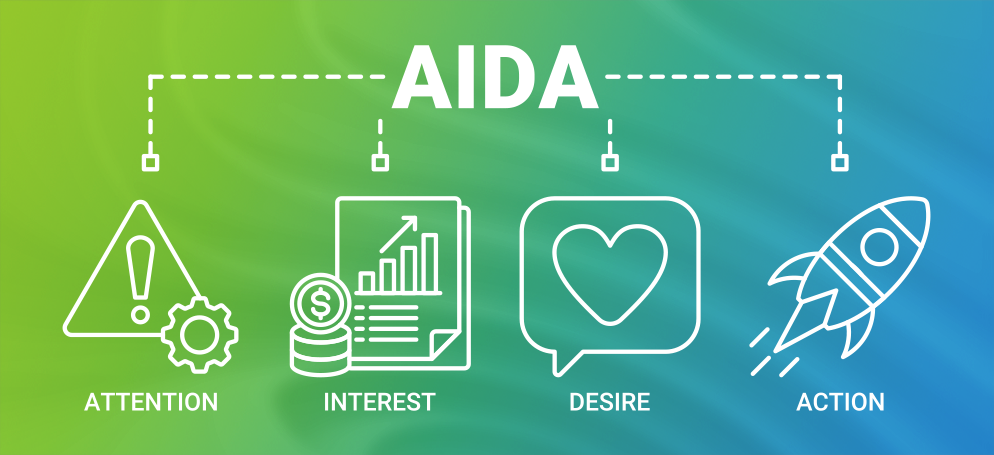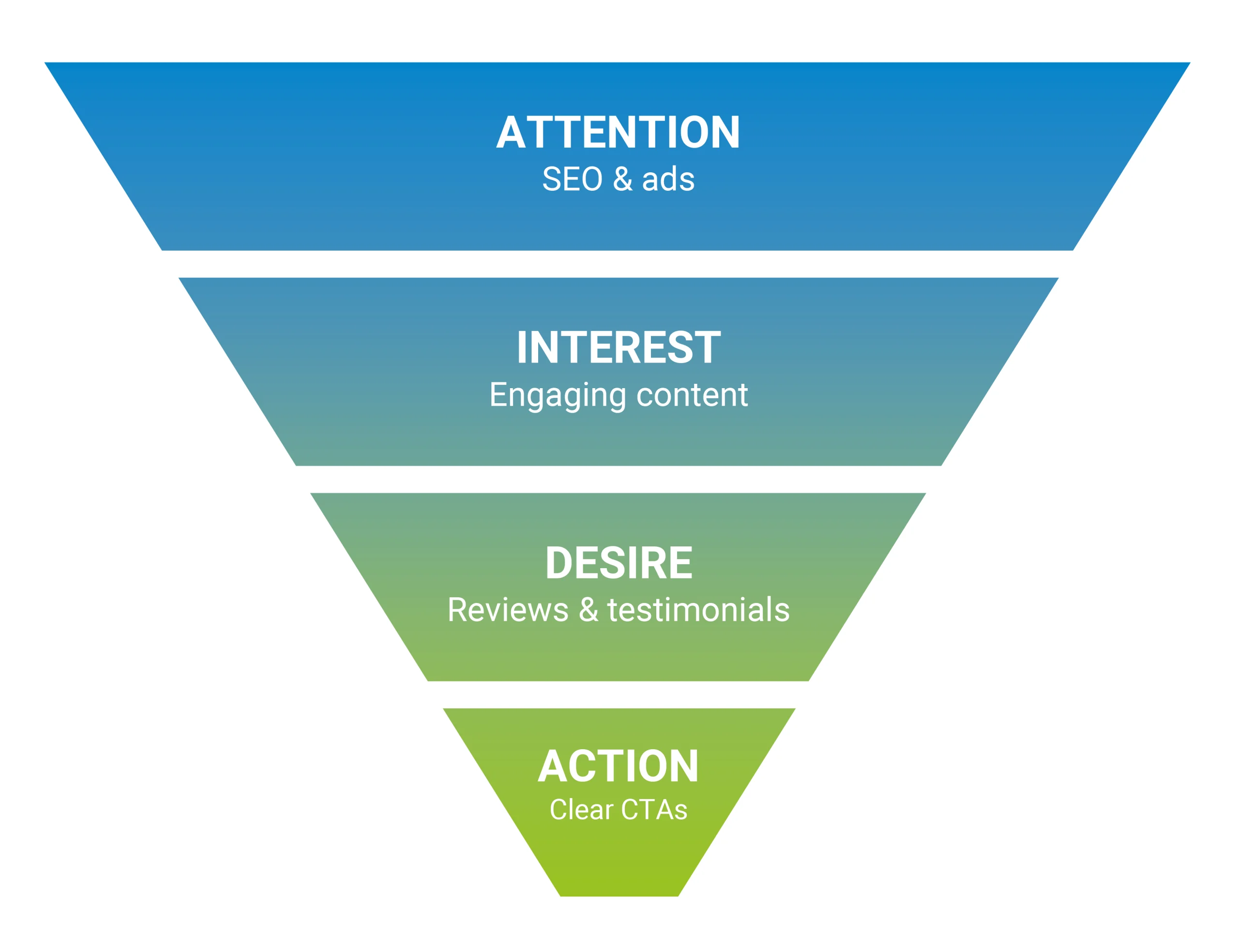How to improve your display marketing performance in 2025
Learn the five key elements of display marketing, from goal-setting to creative strategy, targeting, and optimisation, to boost brand awareness and conversions.

Marketing trends change, but human psychology doesn’t. That’s why a framework created over a century ago – AIDA – still shapes how brands capture attention, build interest, spark desire, and drive action. Developed in 1898 by advertising pioneer Elias St. Elmo Lewis, AIDA breaks down the journey from awareness to conversion in a way that’s as relevant today as ever. Whether you’re optimising a landing page, crafting an ad, or fine-tuning a sales funnel, understanding AIDA can sharpen your strategy and boost results. Let’s take a closer look at how this classic model applies to the digital age.
The AIDA model breaks down the key stages a consumer moves through before making a purchase: Attention, Interest, Desire, and Action. While digital marketing has evolved, these psychological triggers remain essential for guiding potential customers toward conversion.
Capturing attention
 Most buying journeys begin online, making visibility the first hurdle. Strong SEO strategies help brands appear in search results, while paid social and PPC campaigns put products in front of the right audience. Digital PR and social media amplify brand presence, ensuring businesses are seen where customers are already looking.
Most buying journeys begin online, making visibility the first hurdle. Strong SEO strategies help brands appear in search results, while paid social and PPC campaigns put products in front of the right audience. Digital PR and social media amplify brand presence, ensuring businesses are seen where customers are already looking.
Building interest
Once a brand catches attention, the challenge is keeping potential customers engaged. This is where content plays a crucial role – whether it’s a well-timed blog post answering a common question, an insightful webinar, or a compelling case study. Establishing expertise, providing real value, and avoiding an immediate sales pitch all contribute to keeping audiences interested.
Creating desire
Interest alone isn’t enough – people need to feel a connection to your brand. This stage is about reinforcing why your product or service is the right choice. Email marketing nurtures leads with relevant content, while social proof – reviews, testimonials, and user-generated content – helps establish credibility. When potential buyers see others benefiting, they’re more likely to want the same experience.
Driving action
Conversion happens when taking the next step feels easy and compelling. A seamless user experience, clear calls to action, and reassuring micro-copy (such as “Cancel anytime” or “Offer ends Sunday”) help remove hesitation. Simple checkout processes, persuasive messaging, and multiple payment options all contribute to sealing the deal.
Ultimately, AIDA is about guiding potential customers through a journey that leads to a confident decision. Now, let’s explore how to apply this framework effectively in digital marketing.
In SEO, content should align with the conversion funnel. At the awareness stage, users search for broad, informational queries (e.g., “best first cars for young drivers”). Creating long-tail content around these queries helps attract users early and build brand visibility. Google’s featured snippets and People Also Ask sections highlight the value of answering such questions.
As users move toward decision-making, they need more targeted content. Optimising product and category pages for high-intent queries ensures they find relevant information without friction. Features like FAQs, testimonials, and review aggregators can further support conversions.
Paid media strategies should be tailored to users’ intent.
At the bottom of the funnel, incentives like price promotions or urgency-driven messaging can push users toward action.
Social platforms offer extensive targeting capabilities for each AIDA stage:
Remarketing helps sustain engagement and build long-term brand loyalty.

Digital PR primarily supports awareness and interest, driving brand visibility through earned media and link-building. While harder to track directly through the funnel, well-placed content – such as product reviews and expert commentary – encourages users to engage and move further down the funnel.
Understanding the end user’s motivations enables campaigns that resonate. Seasonal trends, product benefits, and industry insights can shape link-building efforts, strengthening referral traffic and SEO value.
Applying the AIDA model across multiple channels enhances overall marketing effectiveness by guiding users through the entire conversion journey:
An additional Nurture stage is becoming more relevant – post-purchase engagement, such as loyalty programs and personalised follow-ups, helps drive retention and advocacy.
AIDA is a universal framework, but its application varies across regions because of cultural differences in consumer behaviour. For example, in high-context cultures like Japan, trust and relationship-building play a crucial role in the ‘Interest’ and ‘Desire’ stages. Subtle messaging, brand credibility, and social proof are more influential than direct calls to action. In contrast, low-context cultures such as the US favour a more direct approach, with bold messaging and urgency driving conversions. (Read more about high and low context cultures here.)
Language, symbolism, and digital preferences also affect how AIDA plays out. In some markets, humour grabs attention, while in others, authority and expertise matter more. Understanding these nuances allows marketers to adapt content, CTAs, and engagement strategies to each audience, ensuring the AIDA funnel is as effective globally as it is locally.
Data analytics enhances AIDA’s effectiveness by revealing how real customers move through the funnel. Customer journey mapping, informed by data, helps marketers identify drop-off points, optimise touchpoints, and personalise messaging at each stage.
For example, web analytics can show where users lose interest (Interest stage) or hesitate before converting (Action stage). Heatmaps and A/B testing refine content placement, while predictive analytics anticipate customer needs, allowing brands to address objections before they arise. Integrating data-driven insights can make AIDA more dynamic and responsive, leading to higher engagement and conversion rates.
Digital marketing is evolving rapidly, and while some see the AIDA model as outdated, it remains a valuable framework – provided it adapts to new technologies and consumer behaviours. AI, machine learning, and emerging digital trends are reshaping how brands capture attention, build interest, create desire, and drive action.
AI-driven personalisation, for example, enhances the ‘Interest’ and ‘Desire’ stages by tailoring content and recommendations in real time. Machine learning-powered recommendation engines refine customer searches based on browsing history, while AI chatbots provide instant support, reducing friction before conversion. Voice search is also shifting how brands attract attention, requiring more conversational, question-based content to align with how people interact with smart assistants.
Meanwhile, interactive and immersive content – such as AR shopping experiences and live commerce – keeps audiences engaged, making the AIDA journey feel more dynamic. With AI-powered analytics, marketers can track how users move through the funnel, refining strategies and automating personalised touchpoints to improve engagement and conversions.
While AIDA remains a widely used marketing framework, other models offer different perspectives on customer behaviour and decision-making. Depending on your goals, one of these alternatives may be more effective:
1. PAS (Problem, Agitate, Solution)
PAS focuses on addressing a pain point, making it feel urgent, and presenting a resolution. It’s particularly useful for direct response marketing, persuasive copywriting, and sales funnels.
2. See, Think, Do, Care
Developed by Google evangelist Avinash Kaushik, this model aligns digital marketing strategies with user intent:
3. The Hook Model
Developed by Nir Eyal, this is particularly relevant for habit-forming products (apps, social platforms, subscription services):
4. ACCA (Awareness, Comprehension, Conviction, Action)
A variation of AIDA, ACCA emphasises understanding and belief before action:
5. The 5 Stages of Awareness (Eugene Schwartz)
Schwartz’s framework helps tailor messaging based on how much the audience already knows:
Each of these models has its strengths depending on the audience, product, and marketing channel. While AIDA is a solid foundation, adapting your approach to fit specific goals often yields better results.
. . .
AIDA isn’t an outdated relic – it still works. But in today’s digital world, it needs a smarter, more adaptable approach. Different markets, different cultures, different behaviours – one-size-fits-all won’t cut it. The key? Understanding what drives your audience at every stage, from that first spark of interest to the final click. Want to make AIDA work harder for you? Let’s talk.